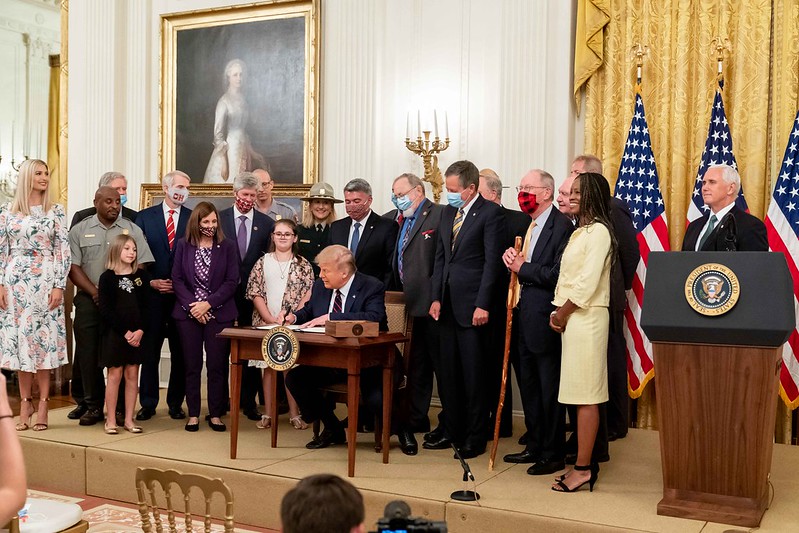WASHINGTON, D.C. – President Bush has proposed a $2.31 billion budget for the Bureau of Indian Affairs (BIA) for Fiscal Year 2004, an increase of $62.0 million over the FY2003 request, to improve the Interior Department’s management of individual Indian and tribal trust assets, to operate new tribally-operated detention centers and to develop tribal economies. The request also maintains the President’s commitment to eliminate the school maintenance backlog and provide tribes with greater opportunities to directly operate BIA schools. Payments for Indian water and land claims settlements also continue.
“With this budget request, the President makes clear his firm commitment to improving the lives of Indian people through trust reform, education and economic development,” said acting Assistant Secretary – Indian Affairs Aurene M. Martin. “The Bureau will be prepared to meet these goals with Congress’ support.”
The FY2004 budget request provides new funding to support the Department’s plan to reform management of its fiduciary obligations to the Federally recognized tribes and individual Indians. The request includes increases of $32.0 million to modernize information technology systems and security to support trust and non-trust programs; $13.0 million to expand a pilot program to reduce the fractionalization of individual Indian land ownership interests into a nationwide effort and $7.6 million for enhanced resource management programs related to trust assets.
The BIA oversees a 185-school system comprised of elementary and secondary day and boarding schools serving almost 48,000 students. The FY2004 budget request for school construction and repair is $292.6 million, including $131.4 million to replace at least seven BIA funded schools including Enemy Swim Day School, Waubay, S.D.; Isleta Elementary School, Isleta, N.M.; Mescalero Apache School, Mescalero, N.M.; Navajo Preparatory School, Farmington, N.M.; Pueblo Pintado Community School, Cuba, N.M.; Turtle Mountain High School, Belcourt, N.D., and Wingate High School, Ft. Wingate, N.M.
Under the Bureau’s FY2004 $528.5 million school operations budget request, an increase of $3.0 million in administrative cost grants is sought to encourage more tribes to exercise their authority to operate BIA-funded schools by providing full funding for start-up costs for the first year of tribal operation of a BIA school. In the School Year 2001-2002, the BIA directly operated one-third of elementary and secondary schools, including four of seven off-reservation boarding schools. The remaining two-thirds of the schools are operated by tribes under BIA contract or grant.
To enhance economic development in Indian Country, the FY2004 budget request seeks $1.0 million in increased funding to expand the BIA’s Indian Loan Guaranty Program to assist tribes with financing for business operations. The increased funding will leverage $20 million in additional guaranteed and insured loans.
To meet Federal requirements for authorized settlements resolving long-standing tribal claims in New Mexico and Oklahoma, the FY2004 budget request includes funding increases to complete the Santo Domingo Pueblo settlement ($6.7 million) and for the first payment on the recent Cherokee, Choctaw and Chickasaw settlement ($10.0 million). The budget also maintains funding at current levels for five additional settlements and reflects decreases due to the completion of two settlements.
Furthermore, funding is requested to continue support for the BIA’s Law Enforcement Program to improve public safety and justice in Indian Country. The FY2004 budget request seeks an increase of $10.0 million for the operation of new detention centers.
BIA continues to make progress in the President’s management agenda for improving management and performance of the Federal government by practicing the Secretary’s vision for citizen-centered management excellence. The 2004 budget for BIA supports the Department’s outcome goals to fulfill Indian trust responsibilities and advance quality communities for Tribes. BIA has worked extensively to integrate the budget with the performance goals in the Department’s new unified strategic plan.
The School Operations, School Construction and Indian Land Consolidation programs were assessed using the Administration’s Program Assessment Rating Tool. The PART process identified actions needed to clarify program purpose and design, and provided recommendations to improve strategic planning, program management and program results. BIA has begun to work on improvements recommended as a result of the assessment.
The Assistant Secretary - Indian Affairs has responsibility for fulfilling the Department’s trust responsibility to American Indian and Alaska Native tribes and individuals, as well as promoting tribal self-determination, education and economic development. The Assistant Secretary also oversees the BIA, which is responsible for providing services to approximately 1.5 million American Indians and Alaska Natives from the nation’s 562 Federally recognized tribes.
-DOI-






